Bookshelf vs Tower Speakers: Which Reigns Supreme?
The age-old debate in the audio world: Bookshelf vs Tower Speakers. At its core, this isn’t just a matter of size, but rather a question of acoustic dynamics, room integration, and, of course, personal aesthetic preference.
Choosing the right speaker for your space is akin to picking the right instrument for a musician. It can greatly enhance the symphony of sounds in your living room or personal listening space.
But fear not! While we’ll dive deep into the nuances of audio fidelity and sonic characteristics, I promise to keep things in lay terms, ensuring you don’t get lost in a maze of audiophile jargon. Ready to pick your winner in the Bookshelf vs Tower Speakers debate? Let’s go!
Brief History of Speakers
To truly appreciate where we are today in the world of speakers, we need to take a sonic journey back in time. Think of a speaker as the voice box of our favorite tunes, stories, and cinematic experiences. The art of amplifying sound has come a long way since its inception.
In the earliest days of audio reproduction, around the late 1800s, we had the mechanical phonograph. It was a primitive device, using a large horn to amplify the vibrations from a spinning disk. While charming in its aesthetics, its sound was, quite frankly, nowhere near the fidelity we’re accustomed to today.
As technology progressed through the 20th century, the birth of the electronic loudspeaker was realized. These devices transformed electrical audio signals into audible sound waves, and their design continually evolved to improve clarity, volume, and the range of sound they could produce.
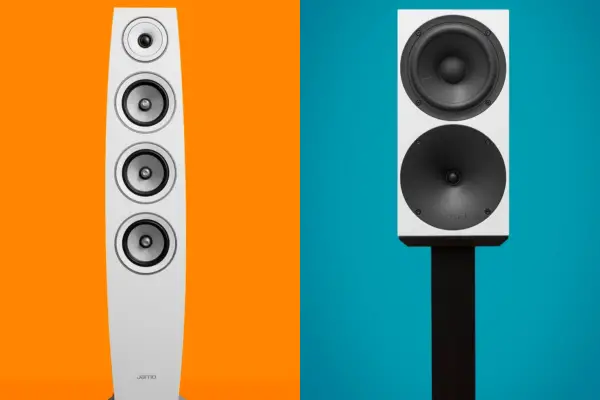
Now, enter the realm of specialized speaker designs. As living spaces and listening preferences varied, the need for diverse speaker sizes and types arose. Bookshelf speakers emerged, offering a compact solution with surprisingly potent sound output. Designed to fit, as the name suggests, on bookshelves or on stands, they were perfect for smaller rooms or for listeners who prioritized space.
On the other end of the spectrum, tower speakers, standing tall and proud, began gracing the floors of dedicated listening rooms. Also known as floorstanding speakers, these powerhouses were built to deliver a comprehensive audio experience, covering the highs, mids, and lows with grace.
Their larger cabinets allowed for multiple drivers (essentially, the components that produce sound), ensuring that everything from the rumble of a bass guitar to the high pitch of a violin was faithfully reproduced.
So, from the large horns of phonographs to the sleek designs of modern bookshelf and tower speakers, the quest for the perfect sound has led to an array of options. And as we’ll see, choosing between bookshelf vs tower speakers today isn’t just a matter of history but more personal preference and space considerations.
Bookshelf Speakers
At its most basic, a bookshelf speaker is a compact loudspeaker, generally designed for use in small to medium-sized rooms. These aren’t your average computer or portable speakers, they’re crafted for those who desire a better sound quality without overwhelming their space.
As for their moniker, the term “bookshelf” stems from their size and placement. Initially, these speakers were sized to fit comfortably on a typical bookshelf, making them a discreet yet effective addition to any room.
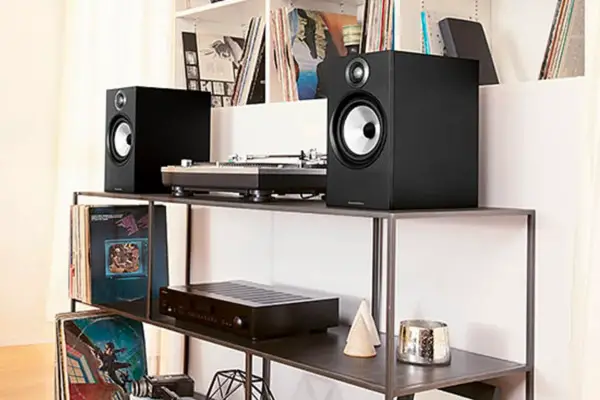
Their design prioritizes delivering clear mids and highs, and when properly placed, they can create a soundstage that belies their size.
Advantages:
Space-Saving: One of the main advantages of bookshelf speakers is their compactness. They can snugly fit in various spots in your room, whether it’s on an actual bookshelf, a desk, or a dedicated speaker stand.
Affordability: Generally speaking, bookshelf speakers, given their size and the materials required, tend to be more wallet-friendly than tower speakers.
Versatility: Their size makes them ideal for urban dwellings like apartments or rooms where space is a premium. Not everyone has the luxury of a dedicated listening room, and bookshelf speakers can be the perfect solution in such scenarios.
Stands and Height Optimization: While they can sit on any flat surface, for those chasing audio perfection, pairing them with stands can optimize the listening height. This ensures that the sound directly hits the listener’s ears at the right angle, creating a more immersive sound experience.
Limitations:
Bass Response: Due to their smaller size and cabinet volume, bookshelf speakers might not produce the deep, room-filling bass that some audio enthusiasts crave. In such cases, pairing them with a subwoofer will fill in the low-frequency gaps.
Full Sound Experience: While they excel in smaller spaces, if you’re trying to fill a larger room or want a complete, floor-to-ceiling sonic experience, bookshelf speakers might fall a bit short. They’re fantastic for their size, but physics does impose certain limitations.
Tower Speakers (also known as Floorstanding Speakers)
A tower speaker is a tall and generally slender loudspeaker that rests directly on the floor, often supported by integrated feet or spikes.
Due to their larger cabinets, these speakers can house multiple drivers, each specialized to handle a specific frequency range – from the rumbling lows to the sparkling highs. This multi-driver configuration allows the speaker to cover a broader spectrum of sound, making the audio experience richer and more immersive.
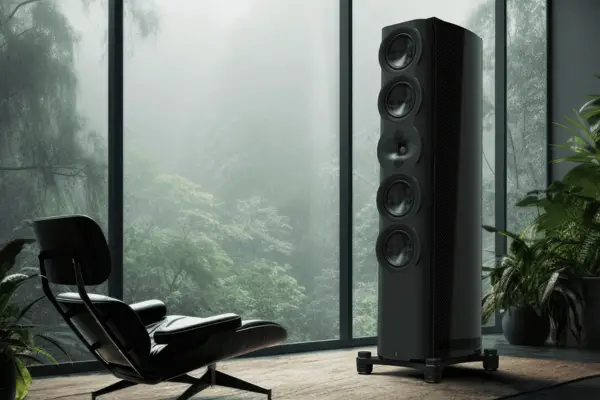
Advantages:
Full-Range Sound: One of the primary advantages of tower speakers is their ability to produce a comprehensive sound profile. Thanks to their size and multi-driver setup, they can delve deeper into bass frequencies without the absolute need for an external subwoofer. This makes for a well-rounded audio experience right out of the box.
Stereo Imaging & Soundstage: With the right placement, tower speakers can create a vivid soundstage that places each instrument or sound effect in a perceptible space. This imaging capability can make you feel like the musicians are right in your room, or you’re in the center of a movie scene.
Aesthetic Presence: Beyond sound, tower speakers can be a visual treat. Their grandeur and design can complement and elevate the décor of a room, making them not just an auditory but also a visual centerpiece.
Suitability for Larger Spaces: Given their output capability, tower speakers are ideal for filling larger rooms with sound. Whether it’s a dedicated listening room, a spacious living area, or a home theater, floorstanding speakers can envelop the space with detailed and expansive sound.
Limitations:
Bulky Design: Their size, while an advantage for sound, can be a limitation when considering room space. They demand floor space and can be a bit challenging to move or adjust due to their weight and size.
Price Point: High-quality tower speakers come with a price tag to match. The combination of more materials, advanced engineering, and the sheer sound output capability can make them a more significant investment compared to bookshelf speakers.
Placement Considerations: While they’re powerful, tower speakers can be finicky about where they stand. To avoid unwanted echoes or resonance, they require thoughtful placement. Too close to a wall or corner can lead to boomy bass, while too far apart can affect stereo imaging.
Bookshelf vs Tower Speakers: Choosing Between the Two
In audio, one size certainly does not fit all. Deciding between bookshelf and tower speakers is a highly personal choice, influenced by many factors. While both have their strengths, understanding what aligns with your needs is paramount. Let’s delve into the crucial considerations that might tilt the balance one way or the other.
Room Size:
The Sound Space: This is the starting point. A smaller room might not have the capacity to let tower speakers shine to their full potential, leading to overpowering bass or overwhelming volume. Conversely, a vast space might make bookshelf speakers sound a bit lost or thin.
Sound Reflections: Every room has its acoustic personality. The way sound waves reflect off walls, floors, and even furniture plays a role. For instance, a room with a lot of soft furnishings might absorb more sound, favoring tower speakers, whereas a room with harder surfaces might benefit from the controlled output of bookshelf speakers.
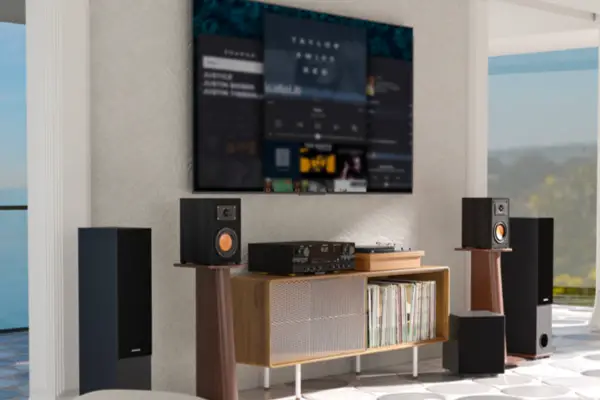
Budget:
While it’s easy to get lost in the allure of tower speakers, your wallet might have other opinions. Generally, you can get top-tier bookshelf speakers for the price of mid-range tower speakers. Always strive for the best quality within your budget, irrespective of the speaker type.
Musical Preferences:
Some of us crave the thunderous undertones of a drumbeat, while others are enamored by the crisp clarity of vocals or the strum of an acoustic guitar. If deep bass and a full sonic range is your jam, tower speakers might be your best friend. But, if you’re more about vocals, acoustics, or generally prefer a more balanced sound, bookshelf speakers can be a perfect fit.
Aesthetic Concerns:
Let’s face it, speakers aren’t just about sound. They’re also furniture pieces. Do you envision a sleek, minimalist space? Or is a grand audio setup with towering pillars more your style? Your aesthetic vision plays a role in the speaker choice.
Flexibility and Future Expansion:
Scalability: If you’re someone who likes to continually upgrade and expand your setup, you might want to consider how each speaker type fits into this vision. Bookshelf speakers can be easily moved to rear channels in a home theater setup if you decide to upgrade your front soundstage later.
Space Flexibility: While tower speakers demand more permanent placements, bookshelf speakers offer the flexibility to be moved around, adjusted, or even repurposed to different rooms if needed.
Pairing with Other Equipment
The symphony that emerges from your speakers is shaped by every component in the chain. Ensuring that these components harmonize perfectly is essential, so let’s discuss some of the pivotal equipment pairings you should be aware of.
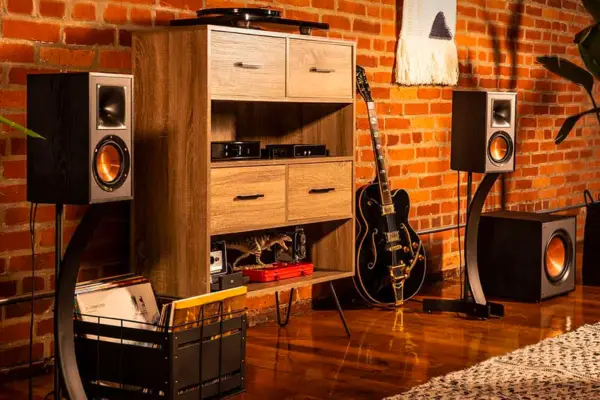
Amplifiers and Speakers: A Symbiotic Relationship:
Power Needs: Each speaker has a recommended power range. Pairing it with an amplifier that delivers power within this range ensures that the speaker operates efficiently without the risk of damage.
Impedance Matching: This technical term essentially means that the resistance offered by the speaker should match the output of the amplifier. Most speakers operate at 4, 6, or 8 ohms, and it’s vital that the amplifier you choose can handle that specific load.
Sonic Characteristics: Beyond technical specs, consider the sonic properties. Some amplifiers might have a warmer sound signature, while others are more neutral. The best pairings consider not just power but also how the amp’s sound complements the speaker’s output.
The Role of Subwoofers:
Filling the Lows: As discussed earlier, bookshelf speakers might sometimes lack the deep bass response. Introducing a subwoofer can bridge this gap, delivering the rumble and punch that might be missing.
Integration with Tower Speakers: While tower speakers are adept at delivering a fuller range of sound, some audio enthusiasts still pair them with subwoofers, especially for home theater setups, to achieve that extra oomph for action sequences or to recreate the nuances of live music recordings.
Speaker Cables and Connections:
Cable Quality: While you don’t need to break the bank, investing in good quality speaker cables can make a difference. They ensure that the signal traveling from your amplifier to your speaker remains pure and free from interference.
Bi-Wiring/Bi-Amping: Some speakers come with two sets of binding posts, allowing for bi-wiring or bi-amping. This can offer improvements in sound quality by separating the signal path for different frequency ranges.
Secure Connections: A snug connection ensures uninterrupted signal flow. Whether you’re using banana plugs, spade connectors, or bare wire, make sure they fit securely into the speaker and amplifier terminals.
Cable Length: Ideally, if you’re setting up a stereo pair, the cable lengths for both speakers should be the same, ensuring that the signal path and the timing remain consistent.
Bookshelf vs Tower Speakers: Which Are Best?
The debate between bookshelf vs tower speakers is and will always be ongoing. As with everything in the audio world, there’s no definitive best, it’s all about individual preferences and circumstances.
Tower speakers may dominate in larger spaces with their commanding presence, while bookshelf speakers shine in cozier settings. Ultimately, the decision isn’t about objective superiority but aligning with your personal desires and room dynamics.
Both have their merits, and both can deliver outstanding audio experiences. Your perfect match lies in understanding your unique needs.

I am a passionate and skilled car audio enthusiast with 15 years of experience in the industry. My journey started when I replaced my first set of factory car speakers, sparking a deep love for high-quality sound. Since then, I have worked as a representative for renowned brands like Kenwood and Alpine.
With a background in both retail and distribution, I have developed a comprehensive understanding of the car audio market. Currently a certified (MECP) installer in the Mobile Electronics industry, my expertise lies in delivering top-notch audio installations. My knowledge, coupled with my genuine passion, makes me the go-to professional for all car audio needs.


